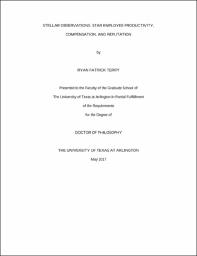| dc.description.abstract | This three-essay dissertation focuses on star employees – most commonly defined as those individuals who are both disproportionately productive and externally visible relative to their colleagues (Kehoe, Lepak, & Bentley, 2016) – and their influence on organizations in terms of performance contributions, the compensation they command, and their ability to enhance firm reputation. The star employee is not a new phenomenon as one of the first and still influential studies within the literature was published over three decades ago (i.e., Rosen, 1981). The influence of star employees is evident across a diverse range of fields including business, academics, the arts, and sports. Perhaps the star employee phenomena is currently no more apparent than in the high-technology sector where talented engineers, programmers, and other individuals are offered extraordinarily high salaries in an effort to maximize their respective organization’s performance.
The allure of the star employee is not difficult to understand as organizations strive for competitive advantage. Stars possess superior levels of human capital – the knowledge, skills, abilities, and other characteristics enabling individuals to perform at high levels (Becker, 1962, 1964; Wright, McMahan, & McWilliams, 1994) – which can be viewed as an organizational resource that produces useful outputs over time (Wright & McMahan, 2011). The uneven dissemination of human capital among firms, particularly at the levels possessed by star employees, makes this resource particularly valuable and in short supply (Castanias & Helfat, 1991; Crook, Todd, Combs, Woehr, & Ketchen, Jr., 2011), leading to the potential for competitive advantage (Barney, 1991). This competition for human capital among rival firms has been described as ‘The War for Talent’ (Michaels, Handfield-Jones, & Axelrod, 2001), and has been the subject of academic research (e.g., Call, Nyberg, & Thatcher, 2015) as well as popular press articles (e.g., Streitfeld, 2015), signaling the significance of this phenomenon among scholars and practitioners.
The first essay uses meta-analytic techniques to assess the extant literature that empirically measures the relationship between the presence of a star employee and organizational performance. Framed by the resource-based view (Barney, 1991) and grounded in human capital theory (Becker, 1964), evidence is presented that supports a direct relationship between the presence of a star employee and organizational performance. This relationship, however, is not identical across all studies and is significantly influenced by how the independent variable is defined as well as when the measure of organizational performance is captured. Studies identifying stars based on performance report stronger relationships between the presence of a star and organizational performance versus studies that require that both performance and external status criteria are met when identifying stars. Furthermore, analysis indicates that the relationship between the presence of a star employee and organizational performance significantly differs in magnitude depending on whether an operational or global measure of organizational performance is used as the dependent variable, suggesting that stars are able to appropriate some of the economic rent which would otherwise show up as organizational profit.
The second essay investigates how competition among rival organizations for human capital impacts compensation offers to stars in employee acquisitions. The positive association between star employees and their organization’s performance suggests an intense battle for these resources is taking place among rival firms in the external labor market. Sometimes referred to as a talent war, organizations beg, borrow, or steal to attract defectors from competitors in an attempt to gain competitive advantage. But are these tactics paying off? Using signaling theory, I argue that organizations may be offering compensation premiums to star employees as a result of misinterpreting signals within the external labor market. Relying on data from the Major League Baseball free agency market, I provide evidence that organizations are likely to pay a compensation premium to an individual based on their prior performance, visibility, experience, and desirability.
The third essay extends the notion that star employees are overvalued in the external labor market and addresses how a star’s value to the firm may be supplemented. Organizations – particularly those in human capital-intensive industries – that have engaged in the talent war for star employees, may have received less than they bargained for (Groysberg, Lee, & Nanda, 2008; Terry & McGee, 2016). Consequently, firms may be looking for other ways in which a star employee can contribute to organizational productivity and effectiveness. I argue that organizations can leverage their star talent within the recruitment process; one of the most urgent problems faced by many contemporary organizations (Ployhart, 2006). This study examines if and how stars may enhance organizational recruitment efforts. In a 2 × 2 factorial design experiment (n = 184), evidence suggests that the presence of a star employee signaled organizational reputation to potential applicants in the external labor market, in turn, increasing attraction to the firm and the likelihood that they will pursue the application process further. Results provide evidence that star employees can trigger signaling-based mechanisms early on in the recruitment process, leading to desirable organizational-level recruitment outcomes.
This dissertation not only advances the star literature, but the combined results also contribute to resource-based theory, signaling theory, and human capital theory. In the following pages, researchers will find new evidence and areas uncovered for future lines of inquiry. This collection of essays should also be of interest to practitioners across a broad range of industries including, but not limited to, software development, biotechnology, banking, and sports. The reported results provide a greater understanding of the impact that stars have on organizations, which may be considered when managers are faced with the option of utilizing star talent as a means of achieving competitive advantage. The intent of this dissertation is to provide insight to scholars who are interested in star research and practitioners who manage organizations in the middle of a talent war that is far from over. | |


